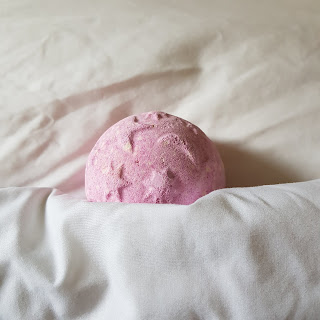(한국어로 된 포스트를 찾으시나요? 그렇다면 여기를 클릭해 주세요!)
Lush has just recently released a new product: The Jelly Bomb! This has caused a lot of commotion in the community. These new bath bomb-style products are meant to provide a bath bomb experience with the added element of slime or jelly in your bath tub. This may sound a little unusual to the uninitiated and honestly, it is a bit odd on the first try, but it turns out to be a very enjoyable, skin nourishing product.

The bath bombs come in four regular line varieties and two seasonal varieties. We have tried them all and we have found some of the scents more enjoyable than the other (see our Instagram account for our personal rankings) but we did enjoy the experience of a jelly bath, as a whole. Lord Fizz was surprised when he started to see on social media that many people were not enjoying their Jelly Bomb experience. As a responsible Lord of Fizz, he sought out the plaintiffs and noted their problem.
Generally, the complaint was this: "My Jelly Bomb is not dissolving." This was perplexing because after six different tries, that had never happened to our love struck bathers. So, Lord Fizz launched his own personal investigation, hoping to unlock the mysteries of Jelly Bombs. Utilizing his limited knowledge of chemistry, his Jelly Bomb investigation began!
If we think about dissolving, or in this case, the lack of dissolving, we can remember our very basic science classes as younger people and think of the terms we learned there: "Solute" "Solvent" "Osmosis" "Dissolve" and "Saturation." Just like a normal bath bomb, when using a Jelly Bomb there is a chemical reaction between sodium bicarbonate and water that creates a beautiful foaming display as the bath bomb dissolves in the water. However, there is an extra ingredient in a Jelly Bomb that works to create its' unique "jelly" effect and that is... Sodium Alginate. This is a sodium salt of the naturally occurring polysaccharide chain Alginic Acid, that is found in the cell walls of cold water brown algae.
Just like Sodium Bicarbonate (our old school fizzing friend) Sodium Alginate does need to dissolve in water. So, we come to our first potential hurdle: Saturation. For a bath bomb, or in this case a Jelly Bomb, to be insoluble or undissolvable, in water, the amount of bubble bars, soaps, shower gels etc. would have to be so high that the bath water would be a sludge, verging on the point of solidity. We can assume that if a bath that is loaded with other products, it may slow the rate of dissolving. Although, even the soapy-est of baths though could not inhibit our Jelly Bomb from dissolving in the water 100%. Considering this, I would not think that water saturation could be a reason why a Jelly Bomb could not preform.
The next cause on our list is Temperature. Many Lushies have claimed, online, that a certain temperature of water is necessary to see the Jelly Bombs dissolve and act properly
. It would make sense that a higher temperature could facilitate a more effective reaction and a quicker time but if we consider the process of osmosis and think about how the jelly bomb is dissolving in the water, we can see that a low temperature bath water will not result in a full-stop of the dissolving of the Sodium Alginate. It is true however, that as osmosis is the passive movement
of particles from higher to lower concentrations, a high water temperature would result in a greater kinetic energy and thus, an environment
in which the jelly bomb would dissolve faster.
What causes a Jelly Bomb to clump up and not dissolve? Well, according to my research and the research of several academic sources* the answer is very simple. It is the presence of Calcium in the water. When Sodium Alginate is exposed to free flowing calcium ions of Ca2+ (or other weak sources of calcium) it likes to grab onto them and create a cross-linked bond that will result in large clumps of the gel. This is the same reaction that would come from you boiling Sodium Alginate in water and letting it set, like Jell-o. That is also why, if the bomb does dissolve well in your water, the gel will attach and form on your skin and body hair (as minute sources of calcium are present on the surface of your skin and hair.)


It would seem that presence of this simple mineral has the potential to ruin your jelly bath experience. According to some sources Lord Fizz found online the UK has a large concentration of hard mineral rich water in the southern part of the country, with the hardness of the water diminishing as you go north. The US and Canada have a lot more geography that lends itself to hard water. Finding almost 60% of the continent saturated with high mineral content hard water. The mineral content of the terrain undoubtedly contributes to the presence of calcium in the water.
If you want to know if calcium is the culprit of your conundrum you can invest in a water hardness tester to see if it is present in your bath water. You might also be seeing build up of scum in your bathtub or in the tiles in your home! A water softener is an option but it can be expensive. You can also buy some unscented chemical additives that can eliminate the ions in the water and give you a jelly-perfect bath. (Though, this method is untested!)
* Waldman, AS, Schechinger, L, Govindarajoo, G, Nowick, JS, Pignolet,
LH. 1998. The alginate demonstration: polymers, food science, and ion
exchange. Journal of Chemical Education 75(11): 1430-1431.
Belitz, HD and Grosch, W. 1999. Food Chemistry. Berlin: Springer.
992 pgs





then try playing its mini game to find a clue here at https://games.lol/mini-game/jelly-bomb/ have fun
ReplyDelete